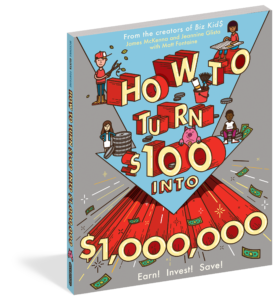The creators of Biz Kid$ (and authors of How to Turn $100 into $1,000,000) share valuable tips to help build your children’s financial literacy. First, they helped your kids set New Years savings goals. Then, they had some great ideas on ways for kids to save without sacrificing fun. Now, they’re sharing some kid- (and parent-) friendly tips on how to avoid money leaks.
Any sports team will tell you that winning the big game not only needs a good offense, it needs a strong defense as well. So in the game of life, when it comes to reaching your financial goals, it’s a good strategy to figure out where you’re leaking money, and to shore up the holes. Here’s a few tips to help your kids (and you!) avoid classic money leaks, and a few strategies to become a smarter consumer.

1. ATM fees.
They say ‘cash is king’ but if you’re constantly visiting ATMs from other banks you could be racking up ATM fees without even noticing. Make a habit of taking out the cash you need at the beginning of the week, from the bank you have your account at, and leave your debit and credit cards at home.
2. Monthly subscriptions and dues.
Monthly payments for data storage, media like Netflix, and all your music downloads can all add up. Individually the costs aren’t much, but together it can get out of hand.
Take stock of what you really need, and cut back to just the essentials. Or better yet, try going without a few for a month.
3. Coupons and flyers.
We know, cutting coupons is a thing of the past, but using smartphone apps like Flipp.com that put them right at your fingertips is a fool-proof way to save. Might be a few dollars here and a few cents there . . . but it all adds up. Making a big purchase? Scour the Internet for the best price using a comparison website like Shopwiki.com.
4. Insurance premiums.
If you’re old enough to drive and pay for your own insurance, ask your broker about getting a discount if you pay annually instead of monthly. Most insurance companies will gladly take all your premium payments in one lump sum, and offer a discount in return.
6. The 24-hour rule.
Envious of your friend’s cool new kicks? Consider implementing a 24-hour ‘think-it-over’ rule on any purchase over $100. Avoiding impulse purchases in favor of meeting your monthly financial goals is a great skill to have. It’s called ‘delayed gratification,’ and even adults struggle with it. But if you can master it in your teens, you’ll be setting yourself up for a lifetime of financial success.
7. Don’t shop when you’re emotional.
Suffered a bad breakup? Take Rule #4, double it, and add 10. That’s because you’re likely to buy something dumb (and live to regret it), just to make yourself feel better. A good defensive strategy would be to leave your cash and cards at home and go window shopping instead.
8. Think differently.
Before you buy that new phone, count the number of work hours it would take cover the cost. If the price tag is $300 and you only make $15/hour that means it will take you 20 hours of sweat to acquire it. Worth it? Maybe . . . but it could be worth more to invest that $300 in a well-researched stock that increases in value over time.
 About the Book:
About the Book:
From the creators of Biz Kid$ and Bill Nye the Science Guy, here is a comprehensive guide for kids to the basics of earning, saving, spending, and investing money.
Written in a humorous but informative voice that engages young readers, it’s the book that every parent who wants to raise financially savvy and unspoiled children should buy for their kids. It is packed with lively illustrations to make difficult concepts easy to understand—all as a way of building financial literacy, good decision-making, and the appreciation of a hard-earned dollar.
Buy the Book
Amazon | B&N | Indiebound | Workman





No Comments